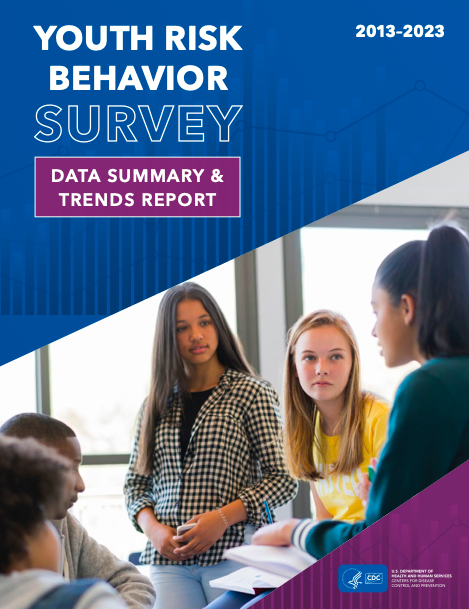 Image 1 of
Image 1 of


Youth Risk Behavior Survey (YRBS) Data Summary & Trends Report: 2013–2023
The Youth Risk Behavior Survey (YRBS) Data Summary & Trends Report: 2013–2023 is a deleted CDC publication, preserved here in its unchanged original form. This report provides a comprehensive analysis of high school students’ health behaviors and experiences over a 10-year period (2013–2023), with a focus on recent trends and disparities based on sex, race/ethnicity, and sexual/gender identity.
Key Features of the Report:
Sexual Behavior Trends: Covers adolescent sexual activity, number of lifetime partners, condom and hormonal birth control use, and STI/HIV testing rates.
Substance Use: Tracks alcohol, marijuana, illicit drug use, and prescription opioid misuse.
Experiences of Violence: Reports on bullying, sexual violence, threats with weapons at school, and safety-related school absenteeism.
Mental Health & Suicidal Behaviors: Highlights trends in depression, suicidal ideation, and suicide attempts.
New & Emerging Data: Examines issues such as parental monitoring, school connectedness, social media use, racism, and unfair discipline in school.
Key Findings:
Declining Sexual Activity & Substance Use: Fewer students reported engaging in sexual risk behaviors and substance use over the past decade.
Worsening Mental Health: Persistent sadness, hopelessness, and suicidal thoughts increased significantly between 2013 and 2023, particularly among female and LGBTQ+ students.
Rising Disparities: LGBTQ+ and female students face higher rates of violence, mental health struggles, and substance use than their peers.
Impact of School Environment: Students reporting school connectedness had better outcomes, while those facing racism, unfair discipline, or bullying experienced worse health trends.
Disclosure:
This document is presented in its unaltered form as originally published by the CDC before its removal.
The Youth Risk Behavior Survey (YRBS) Data Summary & Trends Report: 2013–2023 is a deleted CDC publication, preserved here in its unchanged original form. This report provides a comprehensive analysis of high school students’ health behaviors and experiences over a 10-year period (2013–2023), with a focus on recent trends and disparities based on sex, race/ethnicity, and sexual/gender identity.
Key Features of the Report:
Sexual Behavior Trends: Covers adolescent sexual activity, number of lifetime partners, condom and hormonal birth control use, and STI/HIV testing rates.
Substance Use: Tracks alcohol, marijuana, illicit drug use, and prescription opioid misuse.
Experiences of Violence: Reports on bullying, sexual violence, threats with weapons at school, and safety-related school absenteeism.
Mental Health & Suicidal Behaviors: Highlights trends in depression, suicidal ideation, and suicide attempts.
New & Emerging Data: Examines issues such as parental monitoring, school connectedness, social media use, racism, and unfair discipline in school.
Key Findings:
Declining Sexual Activity & Substance Use: Fewer students reported engaging in sexual risk behaviors and substance use over the past decade.
Worsening Mental Health: Persistent sadness, hopelessness, and suicidal thoughts increased significantly between 2013 and 2023, particularly among female and LGBTQ+ students.
Rising Disparities: LGBTQ+ and female students face higher rates of violence, mental health struggles, and substance use than their peers.
Impact of School Environment: Students reporting school connectedness had better outcomes, while those facing racism, unfair discipline, or bullying experienced worse health trends.
Disclosure:
This document is presented in its unaltered form as originally published by the CDC before its removal.
The Youth Risk Behavior Survey (YRBS) Data Summary & Trends Report: 2013–2023 is a deleted CDC publication, preserved here in its unchanged original form. This report provides a comprehensive analysis of high school students’ health behaviors and experiences over a 10-year period (2013–2023), with a focus on recent trends and disparities based on sex, race/ethnicity, and sexual/gender identity.
Key Features of the Report:
Sexual Behavior Trends: Covers adolescent sexual activity, number of lifetime partners, condom and hormonal birth control use, and STI/HIV testing rates.
Substance Use: Tracks alcohol, marijuana, illicit drug use, and prescription opioid misuse.
Experiences of Violence: Reports on bullying, sexual violence, threats with weapons at school, and safety-related school absenteeism.
Mental Health & Suicidal Behaviors: Highlights trends in depression, suicidal ideation, and suicide attempts.
New & Emerging Data: Examines issues such as parental monitoring, school connectedness, social media use, racism, and unfair discipline in school.
Key Findings:
Declining Sexual Activity & Substance Use: Fewer students reported engaging in sexual risk behaviors and substance use over the past decade.
Worsening Mental Health: Persistent sadness, hopelessness, and suicidal thoughts increased significantly between 2013 and 2023, particularly among female and LGBTQ+ students.
Rising Disparities: LGBTQ+ and female students face higher rates of violence, mental health struggles, and substance use than their peers.
Impact of School Environment: Students reporting school connectedness had better outcomes, while those facing racism, unfair discipline, or bullying experienced worse health trends.
Disclosure:
This document is presented in its unaltered form as originally published by the CDC before its removal.
